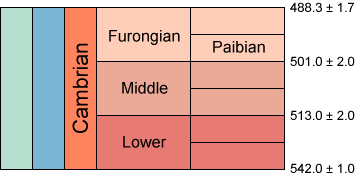Cambrian: the beginning of the Paleozoic Era

The Cambrian covers the period between about 543 million and 488 million years ago. It marks an important point in the history of life on earth, as it is the time when most of the major groups of animals first appear in the fossil record. This event is sometimes called the "Cambrian Explosion", because of the relatively short time over which this diversity of forms appears. It was once thought that the Cambrian rocks contained the first and oldest fossil animals, but these are now to be found in the earlier Vendian strata.
 Animals with hard-shells appeared in great numbers for the first time during the Cambrian. The continents were flooded by shallow seas. The super-continent of Gondwana had just formed and was located near the South Pole.
Animals with hard-shells appeared in great numbers for the first time during the Cambrian. The continents were flooded by shallow seas. The super-continent of Gondwana had just formed and was located near the South Pole.
Panotia, the super-continent that formed at the end of the Precambrian Era, approximately 600 million years ago, had already begun to break apart by the beginning of the Paleozoic Era. A new ocean, the Iapetus Ocean, widened between the ancient continents of Laurentia (North America), Baltica (Northern Europe), and Siberia.
Gondwana, the super-continent that was assembled during the Pan-African orogeny, was the largest continent at this time, stretching from the Equator to the South Pole.
Please click here to complete it